List of colonial buildings in Arequipa
This is a list of the preserved important buildings in the city of Arequipa, in Peru.
Arequipa is a UNESCO World Heritage Site inscribed as "Historical Centre of the City of Arequipa".
List
| Name | Image | Built | Architectural style | Architect(s) | Belonged to the religious order | Source | Location | ||||||||
|---|---|---|---|---|---|---|---|---|---|---|---|---|---|---|---|
| Basilica Cathedral of Arequipa |  | 1540-1844 (the facade was partially rebuilt several times due to earthquakes) | Renaissance, Neoclassical | Gaspar Báez, Andrés de Espinoza, Lucas Poblete |
| ||||||||||
| Basilica and Convent of San Francisco | 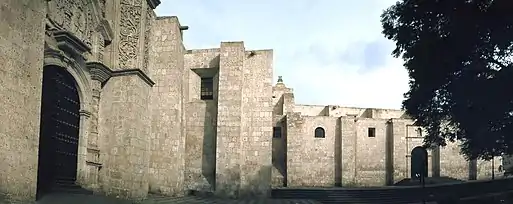 | 1569-late 16th century | Andean Baroque | Gaspar Báez | Franciscans | [1] |
| ||||||||
| Church of La Compañía |  | 1578-1698 | Andean Baroque | Brother Felipe | Jesuits | [2] |
| ||||||||
| Monastery of Santa Catalina de Siena | 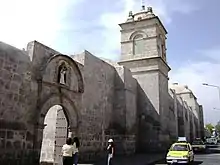 | 1579-1748 | Dominican Second Order | [3] |
| ||||||||||
| Convent of Santo Domingo | 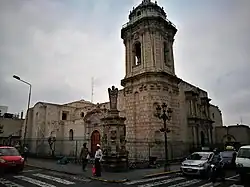 | late 16th century-1677 | Andean Baroque | Esteban Valencia | Dominican Order | [4] |
| ||||||||
| Monastery of Santa Teresa | 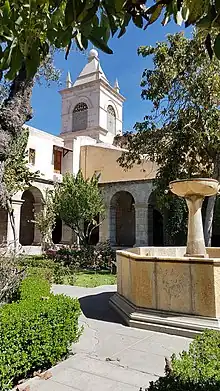 | 1700-1750 | Cloistered Discalced Carmelites | [5] |
| ||||||||||
| Monastery of Santa Rosa | 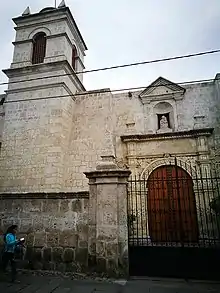 | 1740-1747 | Cloistered Dominican nuns | [6] |
| ||||||||||
| Convent of San Agustín |  | 1574-first half of 18th century | Andean Baroque | Augustinians | [7][8][9][10] |
| |||||||||
| Church of Santa Marta |  | 1580s-1590s | [11][12][13] | ||||||||||||
See also
- Gil González Dávila (1655). Teatro Eclesiastico de la Primitiva Iglesia de las Indias Occidentales, vidas de sus Arzobispos, y Obispos, y Cosas Memorables de svs Sedes, en los que pertenece al Reyno del Pirv. Dedícale a la Magestad del Rey Don Phelipe IV de las Españas, y Nuevo Mundo, y de Otras Coronas, y Reynos, el M. Gil González Dávila fu Coronifta Mayor de las Indias, y de los Reynos de las Dos Caftillas. TOMO SEGVNDO. Madrid, Peru: Diego Díaz de la Carrera. p. 101.
References
- Máximo Neira Avendaño (1990). Historia general de Arequipa. Fundación M.J. Bustamante de la Fuente. p. 289.
- Jorge Polar (1891). Arequipa: descripción y estudio social. Tip. Mercantil. p. 176.
- Alfredo Benavides Rodríguez (1988). La arquitectura en le Virreinato del Peru y en la Capitanía General de Chile (Third ed.). Andrés Bello. p. 49.
- Máximo Neira Avendaño (1990). Historia general de Arequipa. Fundación M.J. Bustamante de la Fuente. p. 288.
- Máximo Neira Avendaño (1990). Historia general de Arequipa. Fundación M.J. Bustamante de la Fuente. p. 295.
- Pedro José Rada y Gamio (1950). Mariano Melgar y apuntes para la historia de Arequipa: obra póstuma. Impr. Casa Nacional de Moneda. p. 44.
- Iglesia de San Agustín (Arequipa). 24 April 2009.
{{cite book}}:|website=ignored (help) - Arellano, Fernando (1988). El arte hispanoamericano. Caracas: Universidad Católica Andrés Bello. p. 261. ISBN 978-980-244-017-7.
- Alfredo Benavides Rodríguez (1988) [1941]. La Arquitectura en el Virreinato del Perú y en la Capitanía General de Chile (Third ed.). Editorial Andrés Bello. p. 74.
- Simón Camacho (1871). El Ferrocarril de Arequipa. historia documentada de su origen, construcción é inauguración. Imprenta del Estado. p. 260.
- Turismo en Iglesia de Santa Marta (Iglesias).
{{cite book}}:|website=ignored (help) - Simón Camacho (1871). El Ferrocarril de Arequipa historia documentada de su origen, construcción é inauguración. Imprenta del Estado. p. 260.
- Juan Gualberto Valdivia, M. Murga (1874). Memorias sobre las revoluciones de Arequipa desde 1834 hasta 1866. M. Murga. p. 349.
This article is issued from Wikipedia. The text is licensed under Creative Commons - Attribution - Sharealike. Additional terms may apply for the media files.